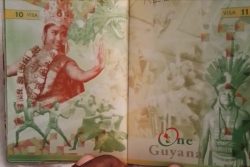Dear Editor,
I have read with interest the responses to the Indian Arrival Committee’s condemnation of a cartoon that appeared in the Sunday Stabroek of June 15, 2008, and the subsequent responses to its response. I would like to use this opportunity to respond to some of the issues raised on the issue in a letter by Vidyanand Persaud in the paper’s June 22 edition. I can only assume that the author of the letter is the learned attorney-at-law who once acted as a Puisne Judge, not that it matters in my response, but if he is, then it may support some points raised herein.
In responding to Persaud’s letter, I wish to mention a point raised on the issue by the Kaieteur News columnist, ‘The Parrot,’ who noted that “…it is easy to ‘hide’ under the guise of freedom of expression, the expression cannot be isolated from the context in which we all operate and the fact that media houses must be responsible”; the operative word being ‘responsible.’ Of course Persaud is free to express his opinion, but in mine his letter is nothing short of a poor attempt at comedy. His freedom of expression is accepted and guaranteed in the same vein as the IAC’s to condemn what they deemed to be offensive. Therefore, in my opinion, his classification of the IAC’s statement as “hysterical” is indicative of his failed attempt to invoke laughter from a serious matter.
As alluded to by the Parrot, the consequences of the work of others who automatically raise the freedom of expression placard, can be devastating as seen from the uproar against the Islamic cartoons in Denmark of which I am sure the learned author is aware. Whilst, like Persaud, I am a defender of freedom of expression, we seem to differ as to its extent in the context of responsibility. Recently some Hindus found the new Mike Myers’ move The Love Guru offensive and it’s not the first film to be so classified by patrons of Indian ancestry and from those in India; the movies Fire and Boom readily come to mind. Who can forget the upheaval created by Salman Rushdie’s The Satanic Verses? His freedom of expression was defended but it doesn’t mean that his writing wasn’t offensive and denigrating to Islam.
This is the point that must be given grave consideration in the realm of responsibility and stability of a nation by those who access the media. In some way this was alluded to by Persaud as a debate in a free society. No qualms here. We can all pen our arguments about the reason or the current war in Iraq; it wouldn’t change the fact that millions there are suffering and millions of others across the globe are short of solutions on how to deal with spiralling fuel prices. This brings me to make a similar point in saying that not because something may be humorous or entertaining means it is not offensive. If it is offensive then people are affected and their sentiments must be duly noted in a free society.
The freedom of expression is not a freedom to harm. Analogies can be made in the following: freedom to acquire a driver’s licence is not a freedom to ‘mow down’ people on the sidewalks; the freedom to drive is not a freedom to disregard the speed limit; the freedom to acquire a gun licence is not a freedom to kill those around you; the freedom to talk is not a freedom to verbally abuse/disrespect others especially in public places where one may be in the presence of his family, including young daughters. I am sure the learned author, if he is the attorney, can associate with this.
I am proud that the IAC, in finding the cartoon to be offensive, has not been fearless in their condemnation of it. Abu Bakr’s letter in the Stabroek News of June 23, cautions of the “…racial sensitivities, with the portrayal of ‘the Other’ in the public space.” He noted “…the ‘Black Pudding lady,’ ‘Portuguese shopkeeper,’ ‘Buck man’ and all other prototypes, neutral and demeaning, of race and class…” He further noted “…that the assaults on Indians, even in symbolic forms such as a cartoon, are allowed to continue, is bad enough…” This should serve to remind us that in a multi-faceted society like ours, something as simple as a cartoon can be a catalyst to the harsh realities of what happened in Iran and other Middle East countries years ago and recently in Denmark.
I am not going to respond to every point raised by Persaud, however I cannot resist commenting on a few. The headgear, the dress and the other accessories portrayed in the cartoon and which are described as “traditional garb,” have been condemned by the IAC. What if the cartoon had shown an Afro-Guyanese (I hate to use the word ‘Black man’) in a loin cloth, which from historical pictures seems to be what they were wearing at the time of captivity during slavery, instead of the old Indian woman? Wouldn’t it have been offensive and denigrating to the African community to be portrayed like that and being asked a question by a member of the media in 2008? Wouldn’t that in itself show that Africans didn’t progress? I am sure the current furore over the cartoon would have been greatly intensified if that were the case.
It is in this context that the condemnation of the headgear in the cartoon by the IAC cannot be seen as being unsupportive of it being worn at Arrival Day celebrations. Every ethnic group grasps the opportunity to ‘deck out’ in traditional garb whenever it arises. Do we see traditional garb being worn to work every day? Do we see it being worn at receptions for a privileged few including the author if he is the attorney? Would it be acceptable if Africans were to turn up in their loin-cloths at public events including these receptions? I am sure the answer would be no.
What we see in most cases is ‘decking out’ in European clothing at the majority of these events. For Indian events, the privileged few, including the author, if he is the same attorney, would spare no ‘pence’ to deck in the most exquisite of Lehengas, Ghagras, Salwar Kameez and Kurta Pyjamas. As a matter of fact, sometimes the clothing is the talk of the reception. What this shows is that all the ethnic groups have come a far way over the years in every stratum of life, including clothing. So to suggest in any public space that we are still trapped in that era can only be seen as offensive.
Persaud also is suggesting that Indians in Guyana and the diaspora are not excited at the prospect of a ‘Black man’ (I really hate that word) in the White House, has shown an affinity to come to hasty and unfounded conclusions, a trait that seems to be indelibly etched in some attorneys’ craft. Of course I am still assuming that the author is indeed an attorney. What mechanisms he used to conclude that Indians may be circumspect to Obama? Of all the Indians I have spoken to Obama seems to be their favourite.
It is unfortunate that the learned author has taken the position he did. It is, however, his right to do so; after all, the caption of his letter, ‘In a free society every sphere of life must be subjected to debate’ points to freedom of expression. Further it is also unfortunate that he would assume that the IAC would consider criticism in any form of the Indo-Guyanese community as a lack of respect for that group. Indo-Guyanese have endured far worse than criticism over the years. Thanks to groups like the IAC another voice can be raised in their defence. Any objection counsel?
Yours faithfully,
Felicia Persaud,
Executive member, IAC
Editor’s note
This newspaper does not subscribe to the view which is implicit in Ms Persaud’s letter that Western dress somehow represents progress in the clothing department, neither that loin cloths – or lapcloths, for that matter – are in some sense indicative of lack of “progress.” Clothing is determined by cultural factors, and in the first instance, by climatic ones. There are parts of the world where the climate would seem to dictate that a “loincloth” would be a most practical garment. On a historical note, however, we would like to point out that over the long period of the trans-Atlantic slave trade, African forms of dress varied considerably from one part of the continent to the next (and perhaps, in some places, from one situation to the next), and many of them were very elaborate. “Historical pictures” do not, in fact, bear out Ms Persaud’s generalized contention about African wear.








